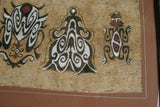CUSTOM FRAMED Rare Tapa Kapa Bark Cloth (Called Kapa in Hawaii), from Lake Sentani, Irian Jaya, Papua New Guinea. Hand painted with natural pigments by a Tribal Artist: Abstract Geometric Stylized Insect Motifs 28" x 22" (DFBA4)
RARE TAPA BARK CLOTH ART FROM PAPUA NEW GUINEA. PROFESSIONALLY CUSTOM FRAMED IN A HAND PAINTED FRAME CREATED TO MATCH THE ART, WITH 2 MATS: ALSO, TAPA BARK CLOTH WAS HAND PAINTED BY NATIVE, WITH NATURAL PIGMENTS (TRIBAL ARTIST). MOTIF OF ELABORATE INSECTS.
Created by a spectacular and reknown artist from Asei.
These Stylized Designs Have Spiritual Meaning.
IN A CUSTOM FRAME WITH 2 MATS:
FINISHED SIZE: 28" x 22"
ITEM: DFBA4. Earthtones.
Shown on most of the photos.
Collected on the premises in Lake Sentani, Irian Jaya (Papua New Guinea
The Sentani lake area of Irian Jaya is famous for abstract paintings written or painted on bark. The wood used is usually wood Khombouw: the outer bark is loosened with beaters, then peeled off from the trunk of the tree by banging the timber, then it is skinned, cut in sections and cleaned by scraping it with a shell. Later The cloth is soaked in water, wrung out, pounded to flatten and then hung up in the sun to dry, a tedious and time consuming process: The thinner, inner bark has been worked with beaters until the cloth has the right thickness and dimensions.
The end result is a beautiful piece of bark that can be painted and used as a decoration.
Later, colorful motifs are painted with natural dyes. The painting is man's work.
Numerous fish, including swordfish & sea turtles, are often painted on bark cloth paintings, coming either from Asei, or an other local village from Lake Sentani : Fish and other water creatures were often portrayed on bark cloth since bark cloth has traditionally been the clothing of the married woman and since, in the Sentani region, it is mostly women who catch fish.
There used to be an old sea inlet which had been separated from the ocean by a volcanic eruption: this is the reason why ocean fish such as swordfish occur on the cloths. Traditionally, pieces of bark cloth were painted with patterns such as wavy lines and spirals (Spirals symbolize the swirl of waves on the lake). The current style, characterized by separate figures that seem to float freely in space, is probably a development of the 1920s and ‘30s.
Official art developers convinced tribal leaders to abolish traditional carving rights and restrictions on the use of motifs, arguing that such concerns were no longer relevant. Among contemporary bark cloth paintings produced by the Asei islanders of Irian jaya, one will notice several unusual pieces clearly combining both Asmat and Sentani motifs. The Asmat motifs were the 'bipane' (boar tusk nosepiece symbol) and hornbill head (in brown), a crocodile (either Sentani or Asmat), Asmat human figures that transform into Sentani spiral motifs called 'fouw' and Sentani fish. Such a fusion is reminiscent of Batik Irian, yet the use of Asmat motifs by Sentani people goes against unspoken rules of conduct among many Papuan artists.



















































